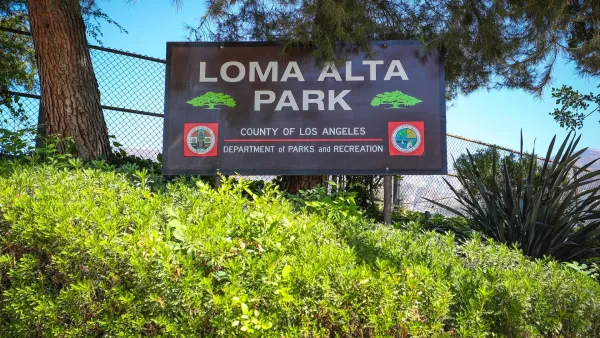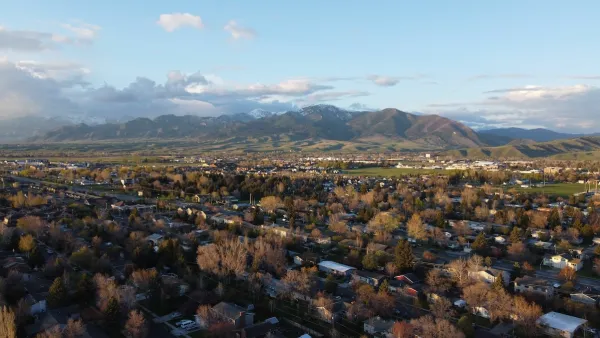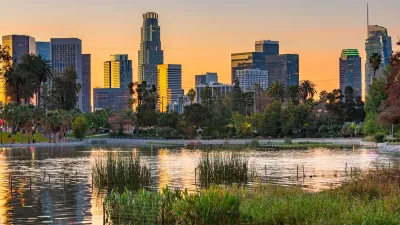L.A. Times architecture critic Christopher Hawthorne and transportation reporter Steve Hymon look at a proposal to raise the sales tax in L.A. to fund public transit. They call it a good opportunity for the city's urbanism, but also a tough sell.
Hawthorne writes:
"On Tuesday, voters in L.A. County will decide the fate of Measure R, which proposes raising the sales tax by a half-penny to pay for new subway and light-rail lines, along with some roadway improvements. (In all, 65% of its proceeds, pegged at roughly $40 billion over 30 years, would go to public transit.) It faces an uphill battle, primarily because it requires two-thirds approval to pass but also because it has divided politicians around the county. Those on the Westside, which would benefit most directly from Measure R dollars -- particularly for a subway extension along or near Wilshire Boulevard -- tend to favor it. Those in areas set to receive less funding, including Long Beach and Pasadena, have strongly opposed it."
"From a political as well as fiscal point of view, to be sure, the measure might have been more stragetically written. Still, its implications for urbanism -- beyond the question of how to move people around the city and get them out of their cars -- have not received nearly enough attention."
"Measure R is an effort to help subsidize a transition in L.A. back to an earlier model of public-transit mobility and perhaps a return to a broader, more comprehensive urban universe as well."
Hymon looks at some of the details of the bill, and answers some of the questions it raises:
"Would Measure R raise enough money to finish all the projects it proposes to build?
Probably not. Most of the projects will need more money to be completed. The list of Measure R projects is long because it was designed to secure political support by offering something for many constituencies.
It also should be noted that many of the projects, such as the subway, have yet to receive environmental clearances that would allow them to start construction.
So how far does $4.1 billion get the subway?
The MTA says that could be enough to extend the line from its terminus at Wilshire Boulevard and Western Avenue to Westwood. The route hasn't been decided, but a recent MTA study recommended that the subway follow Wilshire to Beverly Hills, swing south to Century City and then north to Westwood."
FULL STORY: Measure R is more than roads and rails

Planetizen Federal Action Tracker
A weekly monitor of how Trump’s orders and actions are impacting planners and planning in America.

Maui's Vacation Rental Debate Turns Ugly
Verbal attacks, misinformation campaigns and fistfights plague a high-stakes debate to convert thousands of vacation rentals into long-term housing.

Restaurant Patios Were a Pandemic Win — Why Were They so Hard to Keep?
Social distancing requirements and changes in travel patterns prompted cities to pilot new uses for street and sidewalk space. Then it got complicated.

In California Battle of Housing vs. Environment, Housing Just Won
A new state law significantly limits the power of CEQA, an environmental review law that served as a powerful tool for blocking new development.

Boulder Eliminates Parking Minimums Citywide
Officials estimate the cost of building a single underground parking space at up to $100,000.

Orange County, Florida Adopts Largest US “Sprawl Repair” Code
The ‘Orange Code’ seeks to rectify decades of sprawl-inducing, car-oriented development.
Urban Design for Planners 1: Software Tools
This six-course series explores essential urban design concepts using open source software and equips planners with the tools they need to participate fully in the urban design process.
Planning for Universal Design
Learn the tools for implementing Universal Design in planning regulations.
Heyer Gruel & Associates PA
JM Goldson LLC
Custer County Colorado
City of Camden Redevelopment Agency
City of Astoria
Transportation Research & Education Center (TREC) at Portland State University
Jefferson Parish Government
Camden Redevelopment Agency
City of Claremont





























